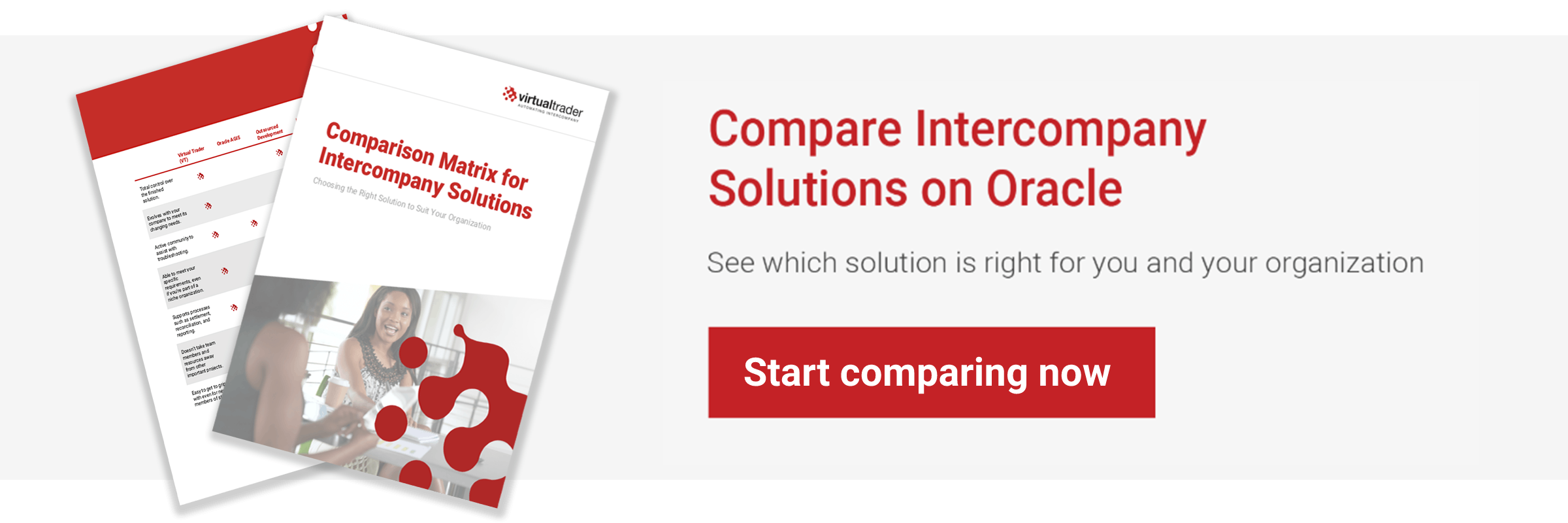As a combined result of company evolution and globalization, changes in regulations, and increased scrutiny from auditors, it’s becoming easier for companies to adopt improper or inadequate intercompany accounting practices. Unfortunately, this can have serious and costly consequences.
Technology solutions can help prevent this by streamlining the process. Some companies delegate to an outsourced development team the task of designing and implementing a solution to help with intercompany reporting. Here’s why this option is popular, plus some drawbacks and other solutions that are available.
The Benefits of Choosing an Outsourced Development Team
Production of Potentially Higher Quality Software
When you outsource an external development team to design, produce, and implement your intercompany management software, the software itself is more likely to be of a higher quality than software developed in-house.
This is because an outsourced development team specializes in producing such software. Team members are experts in software production, from designing and testing to its eventual implementation.
Potentially Shorter Timescale
Since an outsourced development team is expert in producing specialized software, it also means your software is likely to be ready for use more quickly. The team does not require additional training, so it can immediately start designing your software as per your business requirements and know what steps need to be carried out before it can be implemented.
For this reason, choosing an outsourced development team to handle the designing and implementation of your intercompany management software is typically much less time consuming.
Saves Your Resources
When you choose an outsourced development team, you can save valuable resources. For example, an expert team that requires no additional training will handle this task. This saves time, money, and productivity for your company because you wouldn’t need to recruit expensive resources outside of your company’s core business needs.
For instance, if you delegated this task to your in-house team members, they will likely need training. This takes up their time and keeps them away from other important projects. By outsourcing, you’re leaving the development of complex software in the hands of experienced specialists who are more than capable of handling such a project.
The Drawbacks of an Outsourced Development Team
Unlikely to Receive Support
It’s highly unusual for an outsourced development team to provide support for the software after it’s been designed and implemented. Unless it’s stated in a pre-agreed contract, the outsourced team will not be responsible for the maintenance of your software post-development. That means you will have to conduct maintenance and troubleshooting if malfunctions occur.
Risk of Software Not Being to Specification
When you outsource a development team, there’s always the risk of your software not being designed to specification. For instance, it may not work exactly like you anticipated because it isn’t compatible with all the working systems your company originally had in place. Alternatively, the outsourced team perhaps misunderstood and one feature might not be what you had in mind or might be missing altogether.
This is because an outsourced team will never know your company — including its way of working and unique pain points — in quite the way that you and your employees do.
Difficulty in Keeping the Software Up to Date
Outsourced teams are often not responsible for the maintenance of software once it’s been developed. This doesn’t just mean they won’t be able to provide support in the event of a malfunction. It also means they won’t be responsible for its general maintenance, such as updating it as per changes in laws, regulations, and host websites.
For example, your developed software might work alongside other intercompany systems, such as Oracle EBS and AGIS. If EBS and AGIS release new versions or patches — or there are changes in regulations — you will be required to update your software accordingly; otherwise, the software may not work properly (if at all) or be compliant, which can have serious implications.
Sadly, updating developed software isn’t as simple as clicking an “update now” button. Your software is custom built, so the coding will be customized too. That means you’ll need to locate which part of the code needs to be changed. Usually, you will be responsible for this because an outsourced development team won’t play a role in your software’s maintenance.
In addition, you'll not only need to update your software but you’ll also need to stay up to date with when it needs updating. That means you’ll be required to keep up to date with Oracle EBS, AGIS, and relevant laws too — monitoring them in case they change.
Other Options You Can Choose for Intercompany Reporting
Intercompany management is a complex task, and being aware of the existence of technology to help streamline the processes is only half the battle. The other half is knowing which technology options to choose from.
Outsourcing a development team isn’t the only intercompany-reporting-and-management option available to you. There are three other popular options:
-
In-house Development
-
Oracle AGIS
-
Virtual Trader
In-House Development
By developing a solution in-house, you have total control. No one will understand your company, the daily intercompany challenges it faces, and how best to overcome them like you do — especially not an outsourced team.
When you work in-house, you can dictate and create software that’s designed precisely for your needs. This is particularly beneficial if your company has niche requirements; however, the same main problems as outsourcing remain:
-
There’s a lack of support if you experience issues. It’s custom built, so no other organization will have the exact same software. There’s no community forum to turn to, no bank of online support content to read, and certainly no customer service.
-
It consumes valuable resources, such as time and money, especially because you may need to train your in-house development team. You may also need to schedule additional training to your other employees so they can learn how to use the new software.
-
Developing bespoke software is time consuming — and updating it is even more so. You’re responsible for the maintenance of your software and will be required to update the custom coding according to changes in the market and regulations.
These issues are largely due to the fact that you are using a developed solution. Such solutions are almost always built for short-term expediency and therefore have the solution embedded in the code. This makes them largely inflexible and resistant to change.
This leads us to the two final options: Oracle AGIS and Virtual Trader.
Oracle AGIS vs. Virtual Trader
Oracle AGIS is an integral part of Oracle EBS. The module allows you to create and manage intercompany cross charges from one centralized location. While useful for some intercompany management, AGIS is just one of a number of requirements. Many organizations will need greater breadth of scope and flexibility, especially if they’re evolving or planning to do so.
For example, AGIS does not maintain intercompany balances. It creates intercompany journals but is unable to settle, reconcile, or report on them. There is also a lack of aging analysis, making it more difficult for companies to keep track of which liabilities have been settled and, if they haven’t, how old they are.
This is where Virtual Trader comes in. It’s a module that integrates with Oracle EBS and enhances the abilities of AGIS with additional functionalities. Thanks to its Business Rules feature, the Virtual Trader solution grows with a company — through globalization, restructuring, and changes in regulations.
Virtual Trader is a highly intuitive solution that integrates with remote applications. It accepts data from any external source, so it doesn’t matter if a subsidiary sends you data from a slightly outdated version of EBS or if it is using a conflicting combination of software modules.
Outbound transactions can be sent to and from remote applications in the format required by the receiving system.
Another distinctive benefit is that Virtual Trader offers aging analysis. Unlike AGIS, which creates journals and posts them directly to Oracle General Ledger, Virtual Trader includes an Intercompany Subledger that keeps track of receivables and payables before posting them to the GL. Settlement is automated, and the solution will provide aging analysis on those items that haven’t been settled.
Interested in Reading More about the Virtual Trader Solution and How It Compares against Alternative Options?
These two features aren’t the only factors that allow Virtual Trader to significantly aid intercompany reconciliation at period close. If you’re interested in finding out more about the VT solution and how it compares against other popular alternatives, such as the ones mentioned in this blog, download our ultimate comparison guide below.




 US
+1 800 961 9640
US
+1 800 961 9640

